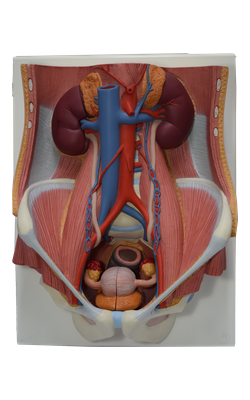Main Model

25 Psoas major

The long, thick, fusiform psoas major lies lateral to the lumbar vertebrae. Psoas is a Greek word meaning “muscle of the loin.” (Butchers refer to the psoas of animals as the tenderloin.) The psoas major passes inferolaterally, deep to the inguinal ligament to reach the lesser trochanter of the femur. The lumbar plexus of nerves is embedded in the posterior part of the psoas major, anterior to the lumbar transverse processes.
Origin: Transverse processes of lumbar vertebrae; sides of bodies of T12-L5 vertebrae and intervening intervertebral discs
Insertion: By a strong tendon to lesser trochanter of femur
Innervation: Anterior rami of lumbar nerves L1, L2, L3
Main Action(s): Acting inferiorly with iliacus, it flexes thigh; acting superiorly it flexes vertebral column laterally; it is used to balance the trunk; when sitting it acts inferiorly with iliacus to flex trunk